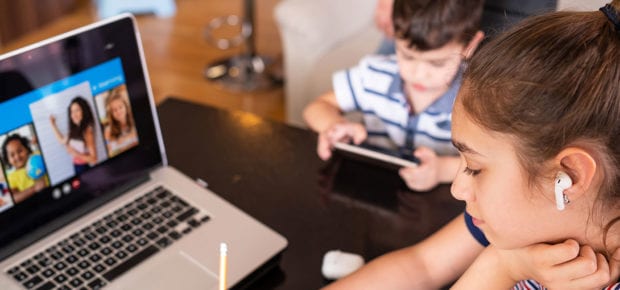June 9, 2020
Many students took a spring break in late March only to come back to their studies through a virtual learning portal due to the COVID-19 pandemic. While virtual learning helps reduce the risk of person-to-person transmission, schools were presented with a new problem: how to ensure every student has internet access so they could continue their education remotely.
“Before COVID-19 led to social distancing and shelter-in-place orders, students who needed access to broadband could use school computer labs, public libraries, on-campus Wi-Fi, public Wi-Fi, and other networks — there are documented cases where students were found parked outside fast food restaurants to use the Wi-Fi for homework,” explains IEEE Senior Member David Witkowski. “This all changed after the pandemic when people were forced to stay home and avoid public places.”
Witkowski says that digital inclusion and equity are crucial to keeping online learning accessible to all students in the Silicon Valley area where he lives. The swift change to remote learning meant that the “homework gap went from an embarrassing inconvenience to a social crisis,” he explains.
“In the wake of the pandemic we can no longer ignore the issue of digital equity and hope it will go away on its own,” says Witkowski.
Witkowski is co-chairing the Deployment Working Group as part of the IEEE Future Networks Initiative that aims to raise awareness of the internet accessibility issue and to encourage accelerated network build-outs at the national and international level.
“Part of the work we’re doing in the Deployment Working Group is calling attention to the socio-economic trends and factors that have driven, and continue to drive the societal shift towards mobile technologies and the apps that run on them,” says Witkowski. “Unfortunately, the deployment of networks that enable these technologies has not been equitable.”
This complements his work at Joint Venture Silicon Valley, where he leads programs that help ensure the region’s residents have adequate access to telecommunications for distance learning, telehealth, banking and online ordering of food and supplies.
“We’ve partnered with organizations to distribute hotspots and laptops, provide digital literacy training and raise awareness of the need for digital equity in education,” says Witkowski. “We’re also working directly with local governments to help them understand the need to accelerate the build-out of wireless networks to serve the neighborhoods where impacted students live. Hotspots are good tools but if there’s no network coverage they’re useless.”
Hotspots convert cellular signals to Wi-Fi to serve laptops with broadband access. If homes do not have the physical infrastructure or adequate wiring to deliver broadband, a hotspot helps students quickly gain internet access to continue their education from home.
“In many cases, the internal wiring of the building is sub-standard and often degraded from age or physical damage,” says Witkowski. “Cellular hotspots deliver broadband without the need for wiring, and they can be easily moved if the family is in a housing transition.”
While many schools are beginning to close out their spring semester and looking forward to fall planning, they are contemplating the likelihood of another term of virtual distance learning.
“We should expect that distance learning is the new normal for students,” says Witkowski. “This means that we must provide broadband to students at home. Broadband is the new textbook, and nobody would expect a student to successfully attend school without books.”
The current challenges of working and learning from home place a huge demand on our infrastructure. Listen to our webinar recording to hear technological and societal perspectives from expert panelists.





 Meaningful Momentum or Running in Place?
Meaningful Momentum or Running in Place? AI Through Our Ages
AI Through Our Ages Liquid Infrastructure: Our Planet's Most Precious Resource
Liquid Infrastructure: Our Planet's Most Precious Resource The Impact of Technology in 2025
The Impact of Technology in 2025 Quantum and AI: Safeguards or Threats to Cybersecurity?
Quantum and AI: Safeguards or Threats to Cybersecurity? Why AI Can't Live Without Us
Why AI Can't Live Without Us Bits, Bytes, Buildings and Bridges: Digital-Driven Infrastructure
Bits, Bytes, Buildings and Bridges: Digital-Driven Infrastructure Impact of Technology in 2024
Impact of Technology in 2024 Emerging AI Cybersecurity Challenges and Solutions
Emerging AI Cybersecurity Challenges and Solutions The Skies are Unlimited
The Skies are Unlimited Smart Cities 2030: How Tech is Reshaping Urbanscapes
Smart Cities 2030: How Tech is Reshaping Urbanscapes Impact of Technology 2023
Impact of Technology 2023 Cybersecurity for Life-Changing Innovations
Cybersecurity for Life-Changing Innovations Smarter Wearables Healthier Life
Smarter Wearables Healthier Life Infrastructure In Motion
Infrastructure In Motion The Impact of Tech in 2022 and Beyond
The Impact of Tech in 2022 and Beyond Cybersecurity, Technology and Protecting Our World
Cybersecurity, Technology and Protecting Our World How Technology Helps us Understand Our Health and Wellness
How Technology Helps us Understand Our Health and Wellness The Resilience of Humanity
The Resilience of Humanity Harnessing and Sustaining our Natural Resources
Harnessing and Sustaining our Natural Resources Creating Healthy Spaces Through Technology
Creating Healthy Spaces Through Technology Exceptional Infrastructure Challenges, Technology and Humanity
Exceptional Infrastructure Challenges, Technology and Humanity The Global Impact of IEEE's 802 Standards
The Global Impact of IEEE's 802 Standards Scenes of our Cyber Lives: The Security Threats and Technology Solutions Protecting Us
Scenes of our Cyber Lives: The Security Threats and Technology Solutions Protecting Us How Millennial Parents are Embracing Health and Wellness Technologies for Their Generation Alpha Kids
How Millennial Parents are Embracing Health and Wellness Technologies for Their Generation Alpha Kids Space Exploration, Technology and Our Lives
Space Exploration, Technology and Our Lives Global Innovation and the Environment
Global Innovation and the Environment How Technology, Privacy and Security are Changing Each Other (And Us)
How Technology, Privacy and Security are Changing Each Other (And Us) Find us in booth 31506, LVCC South Hall 3 and experience the Technology Moon Walk
Find us in booth 31506, LVCC South Hall 3 and experience the Technology Moon Walk Virtual and Mixed Reality
Virtual and Mixed Reality How Robots are Improving our Health
How Robots are Improving our Health IEEE Experts and the Robots They are Teaching
IEEE Experts and the Robots They are Teaching See how millennial parents around the world see AI impacting the lives of their tech-infused offspring
See how millennial parents around the world see AI impacting the lives of their tech-infused offspring Take the journey from farm to table and learn how IoT will help us reach the rising demand for food production
Take the journey from farm to table and learn how IoT will help us reach the rising demand for food production Watch technical experts discuss the latest cyber threats
Watch technical experts discuss the latest cyber threats Explore how researchers, teachers, explorers, healthcare and medical professionals use immersive technologies
Explore how researchers, teachers, explorers, healthcare and medical professionals use immersive technologies Follow the timeline to see how Generation AI will be impacted by technology
Follow the timeline to see how Generation AI will be impacted by technology Learn how your IoT data can be used by experiencing a day in a connected life
Learn how your IoT data can be used by experiencing a day in a connected life Listen to technical experts discuss the biggest security threats today
Listen to technical experts discuss the biggest security threats today See how tech has influenced and evolved with the Games
See how tech has influenced and evolved with the Games Enter our virtual home to explore the IoT (Internet of Things) technologies
Enter our virtual home to explore the IoT (Internet of Things) technologies Explore an interactive map showcasing exciting innovations in robotics
Explore an interactive map showcasing exciting innovations in robotics Interactively explore A.I. in recent Hollywood movies
Interactively explore A.I. in recent Hollywood movies Get immersed in technologies that will improve patients' lives
Get immersed in technologies that will improve patients' lives